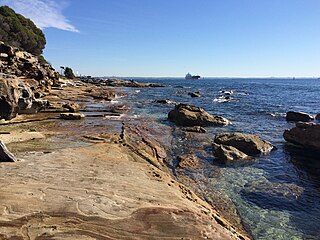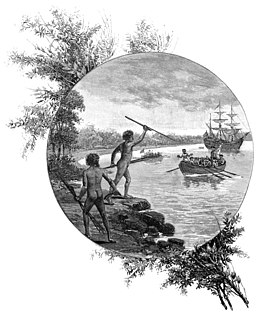
The Kamay Botany Bay National Park is a heritage-listed protected national park that is located in the Sydney metropolitan region of New South Wales, in eastern Australia. The 456-hectare (1,130-acre) national park is situated approximately 16 kilometres (9.9 mi) south-east of the Sydney central business district, on the northern and southern headlands of Botany Bay. The northern headland is at La Perouse and the southern headland is at Kurnell.

The Strategic Petroleum Reserve (SPR) is an emergency stockpile of petroleum maintained by the United States Department of Energy (DOE). It is the largest publicly known emergency supply in the world, and its underground tanks in Louisiana and Texas have capacity for 714 million barrels (113,500,000 m3). The United States started the petroleum reserve in 1975 to mitigate future supply disruptions as part of the international Agreement on an International Energy Program, after oil supplies were interrupted during the 1973–1974 oil embargo.

The Sutherland Shire is a local government area in the southern region of Sydney, in the state of New South Wales, Australia. The Sutherland Shire comprises an area of 370 square kilometres (140 sq mi) and as at the 2016 census had an estimated population of 218,464. Sutherland Shire is colloquially known as "The Shire" and has featured in several reality television series.

The Towra Point Nature Reserve is a protected nature reserve that is located in Sutherland Shire, southern Sydney, New South Wales, in eastern Australia. The 603-hectare (1,490-acre) reserve is situated on the southern shores of Botany Bay at Kurnell, within the Sutherland Shire. The reserve is protected under the Ramsar Convention as a wetland of international importance as an important breeding ground for many vulnerable, protected, or endangered species. The Towra Point Aquatic Nature Reserve is located in the surrounding waterways.

Botany Bay, an open oceanic embayment, is located in Sydney, New South Wales, Australia, 13 km (8 mi) south of the Sydney central business district. Its source is the confluence of the Georges River at Taren Point and the Cooks River at Kyeemagh, which flows 10 km (6 mi) to the east before meeting its mouth at the Tasman Sea, midpoint between the suburbs of La Perouse and Kurnell. The northern headland of the entrance to the bay from the Tasman Sea is Cape Banks and, on the southern side, the outer headland is Cape Solander and the inner headland is Sutherland Point.

Kurnell is a suburb in Sydney, in the state of New South Wales, Australia. It is 21.4 kilometres (13.3 mi) south of the Sydney central business district, in the local government area of the Sutherland Shire along the east coast. Cronulla and Woolooware are the only adjacent suburbs. La Perouse is located opposite, on the northern headland of Botany Bay. The Cronulla sand dunes are on the south eastern headland of Botany Bay. The eastern side of the peninsula is part of Botany Bay National Park, and Towra Point Nature Reserve is located on the western side of the suburb.

Caltex is a petroleum brand name of Chevron Corporation used in 29 countries in the Asia-Pacific region, the Middle East, and Southern Africa.

Ampol Limited is an Australian petroleum company headquartered in Sydney, New South Wales. Ampol is the largest transport energy distributor and retailer in Australia, with more than 1,900 Ampol-bramded stations across the country as of October 2022. It also operates in New Zealand through its subsidiary Z Energy.

National Iranian Oil Refining and Distribution Company (NIORDC) is part of the Ministry of Petroleum of Iran. NIORDC was established on 8 March 1991 and undertook to perform all operations relating to refining and distribution of oil products.

The Cronulla sand dunes, also known officially as the Cronulla Sand Dune and Wanda Beach Coastal Landscape, are an open space, heritage-listed nature conservation, and visitor attraction located on the Kurnell Peninsula at Lindum Road, Kurnell within the Sutherland Shire local government area of New South Wales, Australia. Formerly, it was a site for sand mining, film making, and had use as pastoral property. It is also known as part of Kurnell Peninsula Headland and Cronulla Sand Hill. It was added to the New South Wales State Heritage Register on 26 September 2003.
The Sydney Desalination Plant also known as the Kurnell Desalination Plant is a potable drinking water desalination plant that forms part of the water supply system of Greater Metropolitan Sydney. The plant is located in the Kurnell industrial estate, in Southern Sydney in the Australian state of New South Wales. The plant uses reverse osmosis filtration membranes to remove salt from seawater and is powered using renewable energy, supplied to the national power grid from the Infigen Energy–owned Capital Wind Farm located at Bungendore.
Bulwer Island Refinery was an oil refinery on Bulwer Island near the mouth of the Brisbane River in Queensland, Australia. It is now a petroleum import and storage terminal. It was built by Amoco in the 1960s, taken over by BP in 1984 and converted to an import terminal in 2015. It occupies much of the former island. While it operated, it was the largest oil refinery in Queensland.

The Clyde Refinery was a crude oil refinery located in Clyde, New South Wales, Australia, operating between 1925 and 2013. At the time of its closure it had a refinery capacity of 85,000 barrels per day (13,500 m3/d) and was the oldest operating oil refinery in Australia. It was operated by Shell Refining (Australia) Pty Ltd and owned by the Royal Dutch Shell.

Milford Haven Refinery was an oil refinery situated on the Pembrokeshire coast in Wales, United Kingdom. The refinery began operating in 1973 under Amoco's ownership, but in its final days it was owned by Murco Petroleum. The closure of the refinery was announced in November 2014. The site was sold to Puma Energy in 2015 for use as a petroleum storage and distribution terminal.

The Irving Oil Refinery is a Canadian oil refinery located in Saint John, New Brunswick. It is currently the largest oil refinery in Canada, capable of producing more than 320,000 barrels (51,000 m3) of refined products per day. Over 80 per cent of the production is exported to the United States, accounting for 19 per cent of the country's gasoline imports and 75 per cent of Canada's gasoline exports to the US.

Kwinana Oil Refinery was sited on the shore of Cockburn Sound at Kwinana, near Fremantle, Western Australia. Built by the Anglo-Iranian Oil Company and completed in 1955, it was the largest oil refinery in Australia, with a capacity of 138,000 barrels per day (21,900 m3/d). It was closed by BP in March 2021 to be converted to an import-only terminal.

Petroleum refining in the United States in 2013 produced 18.9 million barrels per day of refined petroleum products, more than any other country. Although the US was the world's largest net importer of refined petroleum products as recently as 2008, the US became a net exporter in 2010, and in 2014 was the largest exporter and the largest net exporter of refined petroleum. As of January 2019, there were 135 operating refineries in the US, distributed among 30 states.
The Whitegate refinery, near Whitegate, County Cork, is Ireland's only oil refinery. It has a capacity of 75,000 barrels of oil per day (bpd), sufficient to provide 40 percent of Ireland's fuel requirements. It was commissioned in 1959 and was redeveloped several times and produces a range of petroleum products.
Australia is a major petroleum producer and importer, with a number of petroleum companies involved in upstream and downstream operations. Western Australia is the largest contributor to Australia's production of most petroleum products.

















